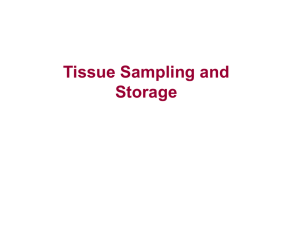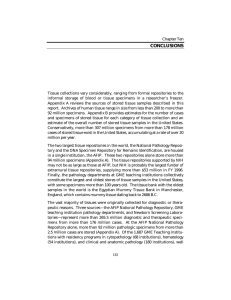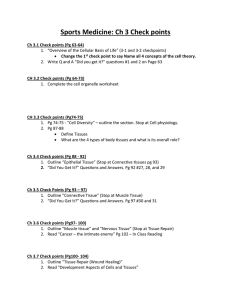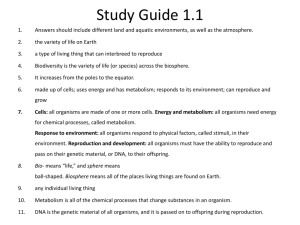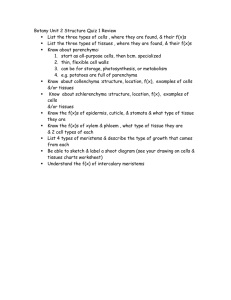SUMMARY
advertisement
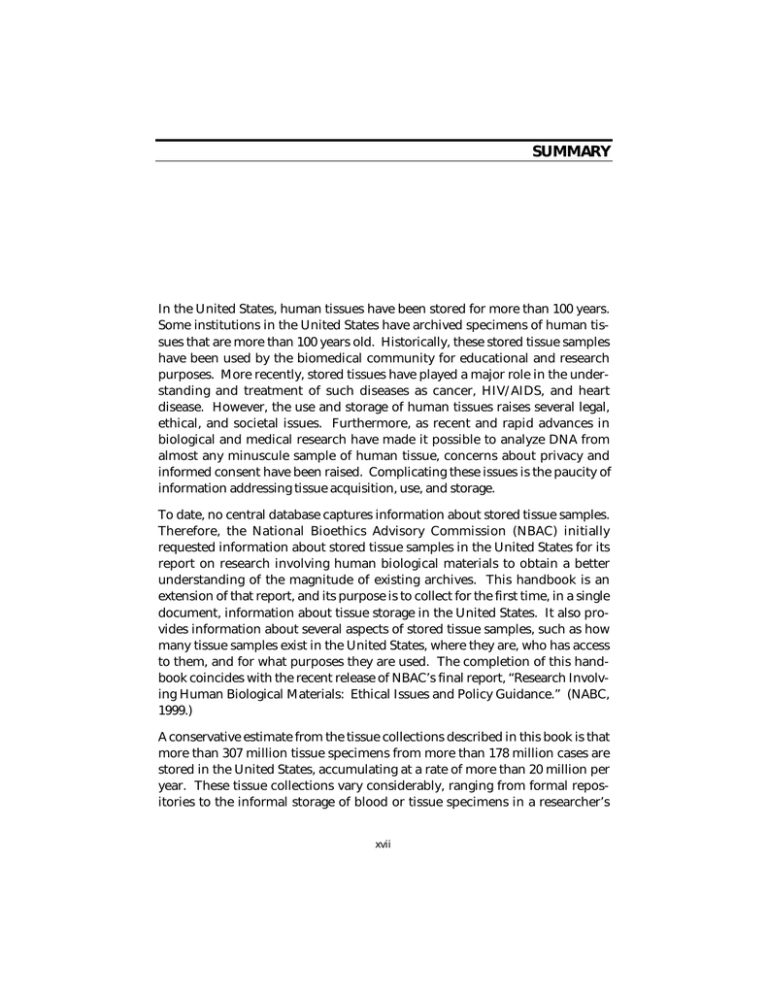
SUMMARY In the United States, human tissues have been stored for more than 100 years. Some institutions in the United States have archived specimens of human tissues that are more than 100 years old. Historically, these stored tissue samples have been used by the biomedical community for educational and research purposes. More recently, stored tissues have played a major role in the understanding and treatment of such diseases as cancer, HIV/AIDS, and heart disease. However, the use and storage of human tissues raises several legal, ethical, and societal issues. Furthermore, as recent and rapid advances in biological and medical research have made it possible to analyze DNA from almost any minuscule sample of human tissue, concerns about privacy and informed consent have been raised. Complicating these issues is the paucity of information addressing tissue acquisition, use, and storage. To date, no central database captures information about stored tissue samples. Therefore, the National Bioethics Advisory Commission (NBAC) initially requested information about stored tissue samples in the United States for its report on research involving human biological materials to obtain a better understanding of the magnitude of existing archives. This handbook is an extension of that report, and its purpose is to collect for the first time, in a single document, information about tissue storage in the United States. It also provides information about several aspects of stored tissue samples, such as how many tissue samples exist in the United States, where they are, who has access to them, and for what purposes they are used. The completion of this handbook coincides with the recent release of NBAC’s final report, “Research Involving Human Biological Materials: Ethical Issues and Policy Guidance.” (NABC, 1999.) A conservative estimate from the tissue collections described in this book is that more than 307 million tissue specimens from more than 178 million cases are stored in the United States, accumulating at a rate of more than 20 million per year. These tissue collections vary considerably, ranging from formal repositories to the informal storage of blood or tissue specimens in a researcher’s xvii xviii Handbook of Human Tissue Sources freezer. Archives of human tissue range in size from fewer than 200 to more than 92 million specimens. The two largest tissue repositories in the world, the National Pathology Repository and the DNA Specimen Repository for Remains Identification, are housed within a single institution, the Armed Forces Institute of Pathology (AFIP). These two repositories alone store more than 94 million specimens. The tissue repositories supported by the NIH are not as large as those at AFIP, but the NIH is probably the largest funder of extramural tissue repositories, supplying more than $53 million in fiscal year 1996. Finally, the pathology departments at graduate medical education (GME) teaching institutions collectively constitute the largest and oldest stores of tissue samples in the United States with some specimens more than a century old. The vast majority of tissues were originally collected for diagnostic or therapeutic reasons. Three sources, the AFIP National Pathology Repository, GME teaching institution pathology departments, and newborn screening laboratories, represent more than 265.5 million diagnostic and therapeutic specimens from more than 176 million cases. Tissues collected for diagnostic or therapeutic reasons can sometimes be used for research, educational, and qualitycontrol purposes, but the vast majority are not. Several repositories have been established specifically for research. In addition, several very large longitudinal studies collect and bank samples from their study participants. Likewise, a fair amount of research simultaneously creates tissue collections or contributes to tissue banks. Collectively, these tissue collections contain more than 2.3 million specimens. Because these tissues are collected specifically for research purposes, it is not surprising that the use of these tissues has resulted in numerous research publications. Other than for diagnostic and therapeutic purposes or for use in research, tissues are collected and stored for a variety of reasons. Blood banks collect approximately 12 million units of blood a year, but only about 20,000 to 40,000 units are stored at any one time. Also, most of the blood collected is used for transfusions, and very little is used for such other purposes as research and quality control. Organ banks do not collect the same volume of tissue that blood banks do but are very similar in the respect that most of the organs and tissues collected are used for transplants, and very little is available for research. Forensic DNA banks collect and store tissues for use in criminal investigations. The DoD DNA Specimen Repository and some commercial DNA banks store DNA samples for remains identification. Sperm, ovum, and embryo banks store specimens for anonymous donation or for later use by the individual storing the material. Umbilical cord blood banks also store blood for anonymous donation and later use by families banking their newborn’s cord blood. Summary xix Many valuable specimens and data resources exist from a variety of sources, but no centralized database allows researchers to obtain access to and information about them. This RAND handbook brings together information about several sources of stored tissue samples in the United States. It represents the first time that this information has been assembled in a single publication and the first time the magnitude of the archives of stored tissues has been assessed. This handbook may serve as a reference for researchers to identify potential tissue resources. It may also serve as a basis for developing a national database. This handbook will be a valuable resource for researchers who require tissue samples for studies in genetics, cancer, immunology, physiology, and cell biology, among other disciplines. In addition, this handbook will be useful to policymakers, physicians, and other health-care professionals.
